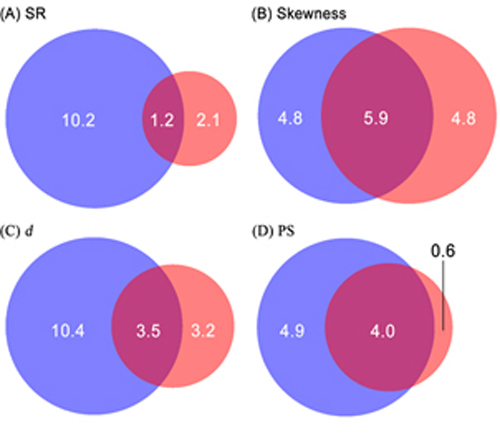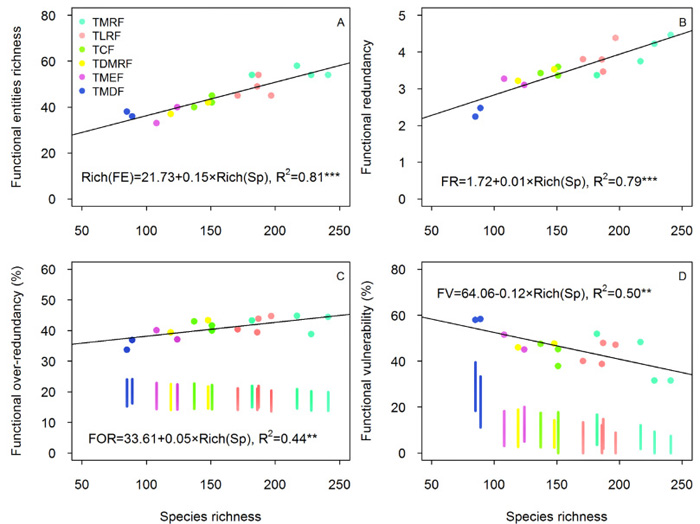
北京不同城市区域蝴蝶多样性及优势种生态位差异
编号
lyqk011233


中文标题
北京不同城市区域蝴蝶多样性及优势种生态位差异


作者单位
1. 浙江工业大学设计与建筑学院 杭州 310023;
2. 北京市园林绿化局 北京 10001;
3. 3 中国林业科学研究院林业研究所 国家林业和草原局林木培育重点实验室 北京 100091;
4. 国家林业和草原局城市森林研究中心 北京 100091;
5. 中铁第五勘察设计院集团有限公司 北


期刊名称
中国城市林业


年份
2023


卷号
21


期号
5


栏目名称
研究论文


中文摘要
蝴蝶对环境变化敏感,其多样性变化对城市化导致的生境变化具有重要指示意义。根据北京环路城市发展梯度,于2019—2020年6—9月对6环内平原区28个公园的蝴蝶多样性进行调查,分析不同城市区域蝴蝶物种组成、蝴蝶多样性差异及优势种和常见种的生态位宽度值与重叠值。结果表明:1)共记录到5科29属37种蝴蝶,不同蝴蝶种类活动月份具有差异;2)菜粉蝶在各个区域中均为优势种,生态位重叠值最大,在3环内、5环外呈现最宽生态位;其他区域的优势种黄钩蛱蝶、柑橘凤蝶的生态位分别在3~4环和4~5环内最宽。3)4环内城市区域的蝴蝶多样性指数显著低于4环外,5环外的公园蝴蝶丰富度和多度显著较高。总体来看,距离城市中心较远的城市公园中蝴蝶多样性水平较高,且部分优势种蝴蝶已成为城市环境适应种。未来城市蝴蝶多样性监测亟需关注生态位宽度较小的特化蝴蝶物种,以期提高城市绿地的生物多样性保育潜力。


关键词
城市生物多样性
物种丰富度
城市化梯度
生态位宽度
生态位重叠


基金项目
中央级公益性科研院所基本科研业务费专项资金经费项目(CAFYBB2020ZB008),国家自然科学基金青年科学基金项目(32301654),浙江工业大学人才引进科研启动项目(202217118000729)


英文标题
Butterfly Diversity and Dominant Species Niche in Different Urbanization Zones of Beijing


作者英文名
Han Dan, Han Conghai, Wang Cheng, She Junying, Bian Qi, Han Wenjing, Yin Luqin


单位英文名
1. School of Design and Architecture, Zhejiang University of Technology, Hangzhou 310023, China;
2. Beijing Municipal Forestry and Parks Bureau, Beijing 100013, China;
3. Research Institute of Forestry, Chinese Academy of Forestry/Key Laboratory of National Forestry and Grassland Administration for Tree Breeding and Cultivation, Beijing 100091, China;
4. Urban Forest Research Center of National Forestry and Grassland Administration, Beijing 100091, China;
5. China Railway Fifth Survey and Design Institute Group Co., Ltd., Beijing 102600, China


英文摘要
Butterfly is sensitive to environmental change, and the change in butterfly diversity is an important indicator of the habitat change caused by urbanization. In accordance with the gradients of urban development along the ring roads in Beijing, the study investigates butterfly diversity in 28 urban parks located in the plain area within the the 6th Ring Road between June and September in 2019-2020, and analyzes the differences in butterfly species composition and butterfly diversity as well as the ecological niche breadth and overlap of dominant and common species. The results show:1) A total of 37 butterfly species belonging to 29 genera of 5families are recorded, and various butterfly species are different in the months of activities; 2) Pieris rapae is the dominant species in all urban zones, with the most extensive niche overlap and the widest niche breadth within the 3rd Ring Road and outside the 5th Ring Road. Polygonia C-aureum and Papilio Xuthus are the dominant species in other zones with the widest niche breadth between the 3rd and the 4th ring roads and between the 4th and the 5th ring roads, respectively; and 3) The butterfly diversity indices in urban areas within the 4th Ring Road are significantly lower than that outside the 4th Ring Road, and butterfly species richness and abundance outside the 5th Ring Road are significantly higher. Overall, the butterfly diversity is higher in urban parks farther from the city center, and some dominant butterfly species have adapted to the urban environment. In the future, in the urban butterfly diversity monitoring, more attention needs to be paid to specialized butterfly species with narrow niche breadth, so as to improve the biodiversity conservation potential of urban green spaces.


英文关键词
urban biodiversity;species richness;urbanization gradient;niche breadth;niche overlap


起始页码
74


截止页码
81


投稿时间
2023/6/8


作者简介
韩丹(1994-),女,博士,讲师,研究方向为城市林业与生态环境设计。E-mail:handan94@foxmail.com


通讯作者介绍
韩丛海(1988-),女,博士,高级工程师,研究方向为城市林业。E-mail:haiconghanccc@163.com


E-mail
haiconghanccc@163.com


DOI
10.12169/zgcsly.2023.06.08.0001


参考文献
[1] MCKINNEY M L.Urbanization, Biodiversity, and Conservation:the impacts of urbanization on native species are poorly studied, but educating a highly urbanized human population about these impacts can greatly improve species conservation in all ecosystems[J].BioScience, 2002, 52(10):883-890.
[2] MCKINNEY M L.Effects of urbanization on species richness:a review of plants and animals[J].Urban Ecosystems, 2008, 11(2):161-176.
[3] RAMÍREZ-RESTREPO L, MACGREGOR-FORS I.Butterflies in the city:a review of urban diurnal Lepidoptera[J].Urban Ecosystems, 2017, 20(1):171-182.
[4] VAN SWAAY C A M, NOWICKI P, SETTELE J, et al.Butterfly monitoring in Europe:methods, applications and perspectives[J].Biodiversity and Conservation, 2008, 17(14):3455-3469.
[5] 马方舟, 徐海根, 陈萌萌, 等.全国蝴蝶多样性观测网络(China BON-Butterflies)建设进展[J].生态与农村环境学报, 2018, 34(1):27-36.
[6] LIZÉE M H, MANEL S, MAUFFREY J F, et al.Matrix configuration and patch isolation influences override the species-area relationship for urban butterfly communities[J].Landscape Ecology, 2012, 27(2):159-169.
[7] TZORTZAKAKI O, KATI V, PANITSA M, et al.Butterfly diversity along the urbanization gradient in a densely-built Mediterranean city:Land cover is more decisive than resources in structuring communities[J].Landscape and Urban Planning, 2019, 183:79-87.
[8] 林芳淼, 袁兴中, 吴玉源, 等.快速城市化区域不同生境类型的蝴蝶多样性[J].生态学杂志, 2012, 31(10):2579-2584.
[9] 林宏伟, 王昌杰, 杨莉, 等.城市化对台州市蝴蝶多样性的影响[J].四川动物, 2018, 37(5):541-547.
[10] 和秋菊, 易传辉, 王珊, 等.昆明市区蝴蝶群落多样性研究[J].西北林学院学报, 2008, 23(3):147-150.
[11] SING K W, LUO J X, WANG W Z, et al.Ring roads and urban biodiversity:distribution of butterflies in urban parks in Beijing city and correlations with other indicator species[J].Scientific reports, 2019, 9(1):7653.
[12] SING K W, DONG H, WANG W Z, et al.Can butterflies cope with city life?Butterfly diversity in a young megacity in southern China[J].Genome, 2016, 59(9):751-761.
[13] SING K W, JUSOH W F A, HASHIM N R, et al.Urban parks:refuges for tropical butterflies in Southeast Asia?[J].Urban Ecosystems, 2016, 19(3):1131-1147.
[14] 李志刚, 张碧胜, 龚鹏博, 等.广州市不同城市化发展区域蝶类多样性[J].生态学报, 2009, 29(7):3911-3918.
[15] LIANG D, YANG S N, PAGANI-NÚÑEZ E, et al.How to Become a Generalist Species?Individual Niche Variation Across Habitat Transformation Gradients[J].Frontiers in Ecology and Evolution, 2020, 8:948.
[16] CLARK P J, REED J M, CHEW F S.Effects of urbanization on butterfly species richness, guild structure, and rarity[J].Urban Ecosystems, 2007, 10(3):321-337.
[17] FLYNN D F B, GOGOL-PROKURAT M, NOGEIRE T, et al.Loss of functional diversity under land use intensification across multiple taxa[J].Ecology letters, 2009, 12(1):22-33.
[18] BLAIR R B.BLAIR, LAUNER A E.Butterfly diversity and human land use:species assemblages along an urban grandient[J].Biological Conservation, 1997, 80(1):113-125.
[19] 付刚, 肖能文, 乔梦萍, 等.北京市近二十年景观破碎化格局的时空变化[J].生态学报, 2017, 37(8):2551-2562.
[20] 王成, 蔡宝军, 王军, 等.北京平原森林建设对策研究与实践成效[M].北京:中国林业出版社, 2021.
[21] PEI N C, WANG C, JIN J L, et al.Long-term afforestation efforts increase bird species diversity in Beijing, China[J].Urban Forestry and Urban Greening, 2018, 29:88-95.
[22] XIE Y C, FANG C L, LIN G C S, et al.Tempo-spatial patterns of land use changes and urban development in globalizing China:a study of Beijing[J].Sensors, 2007, 7(11):2881-2906.
[23] 张新时.中华人民共和国植被图[M].北京:地质出版社, 2008.
[24] ISAAC N J B, CRUICKSHANKS K L, WEDDLE A M, et al.Distance sampling and the challenge of monitoring butterfly populations[J].Methods in Ecology and Evolution, 2011, 2(6):585-594.
[25] LANG B J, DIXON P M, KLAVER R W, et al.Characterizing urban butterfly populations:the case for purposive point-count surveys[J].Urban Ecosystems, 2019, 22(6):1083-1096.
[26] 韩丹, 王成, 殷鲁秦.北京城市蝴蝶蜜源植物网络特征及重要蜜源植物识别[J].生态学报, 2021, 41(22):8892-8905.
[27] HAN D, WANG C, SUN Z K, et al.Microhabitat preferences of butterflies in urban parks:Both vegetation structure and resources are decisive[J].Urban Forestry and Urban Greening, 2022, 71(1/3):127552.
[28] 武春生, 徐堉峰.中国蝴蝶图鉴:标本卷[M].福州:海峡书局, 2017.
[29] 周尧.中国蝴蝶分类与鉴定[M].郑州:河南科学技术出版社, 1998.
[30] 周尧.中国蝶类志[M].郑州:河南科学技术出版社, 2000.
[31] 章士美, 赵泳祥.中国农林昆虫地理分布[M].北京:中国农业出版社, 1996.
[32] 黄秋霞, 张喆, 马红艳.昆明市三类城市公园秋冬季蝴蝶多样性及影响要素[J].中国城市林业, 2023, 21(2):44-50.
[33] MAGURRAN A E.生物多样性测度[M].北京:科学出版社, 2011.
[34] 周立垚, 丁圣彦, 卢训令, 等.人为干扰对传粉昆虫群落物种多样性及其优势类群生态位的影响[J].生态学报, 2020, 40(6):2111-2121.
[35] HAN D, ZHANG C, WANG C, et al.Differences in response of butterfly diversity and species composition in urban parks to land cover and local habitat variables[J].Forests, 2021, 12(2):140.
[36] SOGA M, KAWAHARA T, FUKUYAMA K, et al.Landscape versus local factors shaping butterfly communities in fragmented landscapes:does host plant diversity matter?[J].Journal of Insect Conservation, 2015, 19(4):781-790.
[37] SOGA M, KOIKE S.Relative importance of quantity, quality and isolation of patches for butterfly diversity in fragmented urban forests[J].Ecological Research, 2012, 27(2):265-271.
[38] MATTESON K C, LANGELLOTTO G A.Determinates of inner city butterfly and bee species richness[J].Urban Ecosystems, 2010, 13(3):333-347.
[39] KONVICKA M, KADLEC T.How to increase the value of urban areas for butterfly conservation?A lesson from Prague nature reserves and parks[J].European Journal of Entomology, 2011, 108(2):219-229.
[40] 杨宏, 王春浩, 禹平.北京蝶类原色图鉴[M].北京:科学技术文献出版社, 1994.
[41] 佘珺莹, 韩丹, 王成, 等.北京中心城区小微绿地的蝴蝶多样性特征[J].中国城市林业, 2022, 20(3):1-6.
[42] SNEP R P H, OPDAM P F M, BAVECO J M, et al.How peri-urban areas can strengthen animal populations within cities:a modeling approach[J].Biological Conservation, 2006, 127(3):345-355.


PDF全文
浏览全文


-
相关记录
更多
- 计划火烧对植被和土壤影响研究综述 2022
- 高密度城区野猪生境适宜性与“人猪冲突”潜在风险区识别研究 2024
- 家庭花园对城市生物多样性的贡献与展望 2023
- 近20年来欧洲城市生物多样性研究进展 2022
- 生物多样性指示因子在我国森林景观应用中的有效性强度研究 2017
- 爱尔兰的植物篱和竹林场之间的植物物种丰富度比较 2012
 打印
打印

